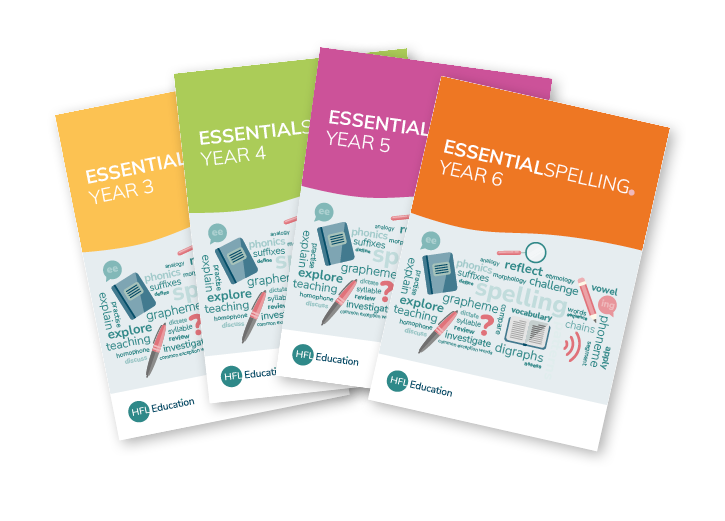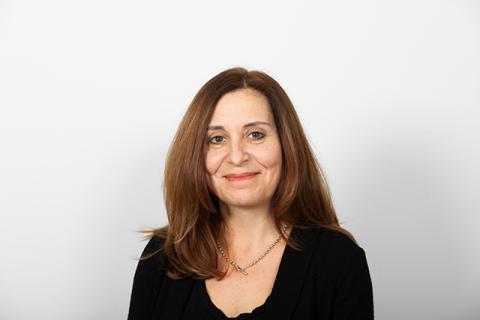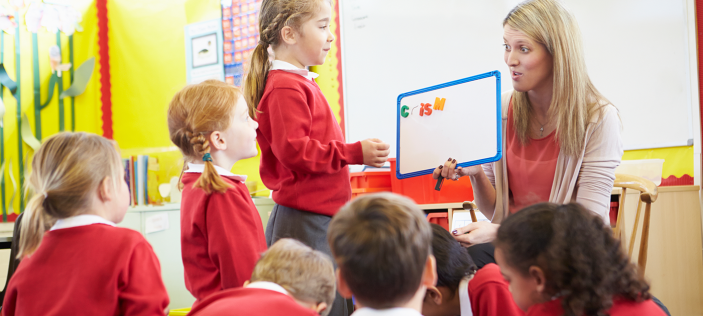With the heightened status that spelling holds in the Teacher Assessment Framework at KS2, leaders will no doubt be looking to raise the profile of spelling across their school. This is particularly relevant if there are a number of pupils across KS2 who are struggling within this area or have gaps in their learning. The current disruption to children’s education will undoubtedly mean that some children will suffer further dents to their spelling knowledge and cracks to their linguistic confidence.
As a class teacher, I would always find it challenging to include the varied needs of all thirty writers in my class within a single lesson: spelling confidence varied hugely no matter which age group I was teaching. As an adviser, I could see other teachers dealing with the same issue. Furthermore, spelling schemes seemed to focus on end of year or phase expectations and there was no support to tailor materials for cohorts, where children were not working at that point.
Around three years ago, my colleague Sabrina and I began working with teachers on a spelling intervention project- Spelling SOS. Through analysis of reams of children’s writing, we had noticed that similar issues occurred universally from Y3 to Y6 and seemed to be preventing children from moving on in their orthographic understanding. We supported KS2 teachers to identify and target specific gaps in children’s spelling knowledge, prioritise the areas that would generate the greatest impact and work through a systematic programme of study with these children. The outcomes for each spelling cohort were superb what teachers told us each time was that they wished they had a resource that could support the rest of their class in this way! This made us realise that, detailed though it was, the spelling programme of study in Curriculum 2014 was not addressing the needs of all children. Could there be another way?
Thus, after much cogitating and deliberating, ESSENTIALspelling was born. This Herts for Learning resource is a whole class approach to teaching spelling that enables all children to succeed and gives teachers the unique tools to make that happen. ESSENTIALspelling can be used as a scheme for spelling on its own, or in conjunction with the school’s existing scheme to give supplementary teaching guidance. The complete resource features a year’s worth of teaching sequences for each year group; all inter-related and all following on in logical progression.
What is different about ESSENTIALspelling?
This spelling resource is different to other spelling schemes. It focuses more on the teaching of spelling so that children understand how to apply patterns, strategies and knowledge to other words and not just a list of words given for that week. It also provides links to prior knowledge and tracks back to related objectives so that teachers can give targeted support to children who are not yet able to spell words from their year group programme of study. In short, ESSENTIALspelling empowers children to build words- they are shown how to become spellers for life, rather than remember spellings for a week.
Unlike other resources, ESSENTIALspelling places an emphasis on the Review stage of the teaching sequence. This is not ‘what did we learn last week?’ but instead: “What do we already know that might help us to spell words in this sequence?” The Review session is vital because it gives teachers an opportunity for assessment for learning and gives pupils the chance to build connections between existing knowledge and new knowledge. Similarly, the Teach part of the sequence has a huge focus in this resource. ESSENTIALspelling provides essential subject knowledge that will support teachers to explain and unpick the learning behind the lesson.
Wherever possible, all children take part in these parts of the sequence regardless of prior spelling attainment. The Review section always tracks back to prior learning and the Teach section introduces new learning as well as strategies for tackling spelling. The premise is that unless children are supported towards age-related spellings, their learning gap will grow wider.
However, this resource does then offer a teacher the chance to tailor learning more specifically to the current needs and spelling attainment of the children. The Practise and Apply sections give children the opportunity to rehearse spelling patterns and use them in context. Then there are two further sections: Minor Gaps and Major Gaps. Every sequence shows teachers how to support the children who have small gaps in their previous learning -as well as those who have not secured the foundations needed for any given sequence- without the need for removing children from the classroom for a separate intervention and without the requirement of additional adult support.
The Practise sections suggest straightforward activities that can be undertaken independently by children during the lesson or even at home. The emphasis here is on exploration and word building, rather than practising a prescribed list of words. Likewise, the Apply sections follow a regular pattern of children discussing their learning and spelling words in the context of short dictations. There might be a suggestion of an extended writing activity to challenge the children to choose and use words independently and in context.
This resource is designed so that children can build on prior learning, make connections with existing knowledge and learn strategies that will help them develop their spelling competence. Pupils are encouraged to articulate their learning throughout the sequence. It is through explaining what they have learnt about the patterns and processes of spelling that they will improve their ability to spell accurately. A key strength of the scheme is, I believe, the fluid nature of it, rather than being a ‘one-size fits all’ approach. There are opportunities for assessment for learning at every turn, so it is as much a diagnostic tool as anything else, helping teachers to identify gaps in learning and enable teachers to rapidly fill in those gaps and rebuild children’s confidence. Above all, ESSENTIALspelling is designed to put the joy of teaching and learning spelling back into the classroom!
ESSENTIALspelling can be purchased for KS2 or individual Year groups from the HFL Education shop. If you would like to see some sample materials, there are a couple of free sequences to download for each year group product.



